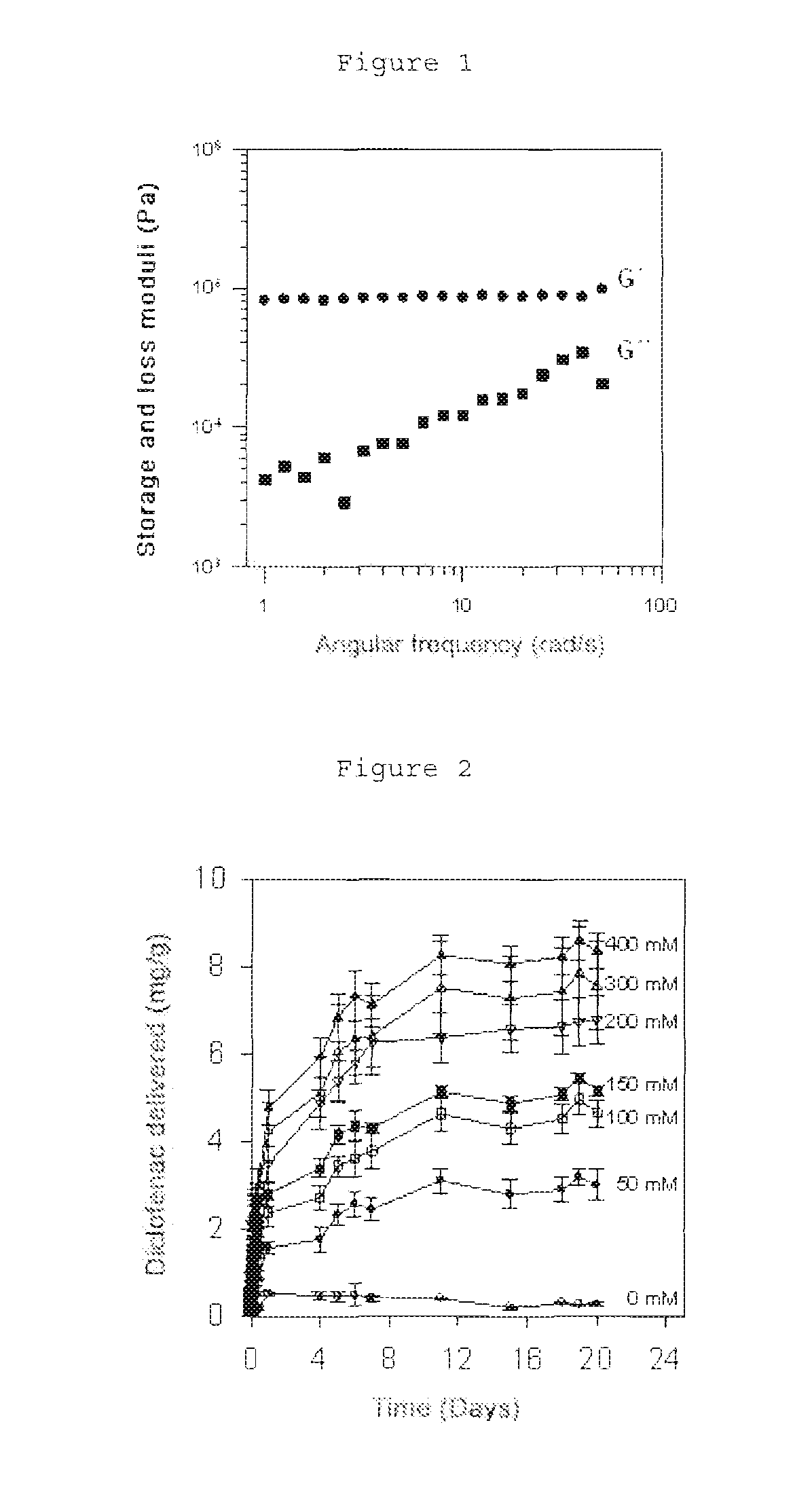Acrylic hydrogels with pendant cyclodextrins, preparation method thereof and use of same as release systems and contact lens components
- Summary
- Abstract
- Description
- Claims
- Application Information
AI Technical Summary
Benefits of technology
Problems solved by technology
Method used
Image
Examples
embodiment
[0038]Examples showing how acrylic hydrogels with pendant cyclodextrins are obtained, the quantification of the cyclodextrin content and the evaluation of the transparency and mechanical properties of the compositions obtained are included below. Examples for preparing compositions which incorporate drugs and release them in a controlled manner are also included. These examples serve to illustrate, not limit, the invention.
[0039]To carry out the preparation of the three-dimensional acrylic hydrogels with pendant cyclodextrin, a cyclodextrin solution with a concentration comprised between 1 and 5% weight / weight is first prepared in a medium formed by sodium chloride 0.5M:dimethylformide 50:50 v / v solution alkalinized with 3% NaOH, using a mechanical or magnetic stirrer and, if necessary, applying ultrasounds. The three-dimensional acrylic hydrogel with glycidyl groups is introduced into this solution such that the weight of the solution is between 10 and 50 times its weight, and the ...
example 1
Method for Obtaining an Acrylic Hydrogel with α-Cyclodextrin, β-Cyclodextrin, Hydroxypropyl-β-Cyclodextrin, Methyl-β-Cyclodextrin or Pendant γ-Cyclodextrin
[0045]A hydroxyethyl methacrylate (HEMA) hydrogel was prepared by dissolving 0.0714 ml of ethylene glycol dimethacrylate (EGDMA, 8 mM), 0.074 g of azoisobutyronitrile (AIBN, 10 mM) and 0.245 ml of glycidyl methacrylate (GMA, 300 mM) in 6 ml of HEMA, injecting the mixture into molds formed by glass plates internally covered with a polypropylene sheet and separated by a silicone frame 0.4 mm thick, and heating at 50° C. for 12 hours and at 70° C. for another 24 hours. The hydrogel sheets were submerged in boiling water for 15 minutes to remove the non-reacting monomers and to facilitate cutting discs 10 mm in diameter. The discs were submerged in water for 24 hours, then in 0.9% NaCl for another 24 hours and finally in water for another 24 hours.
[0046]The wet discs were submerged in portions of 100 ml of solution of α-cyclodextrin, ...
example 2
Method for Quantifying the Cyclodextrin Content of an Acrylic Hydrogel with β-Cyclodextrin, Hydroxypropyl-β-Cyclodextrin or Pendant Methyl-β-Cyclodextrin
[0047]To determine the content of β-cyclodextrin, hydroxypropyl-β-cyclodextrin or methyl-β-cyclodextrin in the acrylic hydrogel compositions with β-cyclodextrin, hydroxypropyl-β-cyclodextrin or pendant methyl-β-cyclodextrin obtained in example 1, the following method was applied. Dry discs of each hydrogel submerged in an aqueous solution of 3-methylbenzoic acid (0.5 mg / ml, 10 ml per disc) were maintained for 48 hours in the dark. Once this time had lapsed, the concentration of 3-methylbenzoic acid was spectrophotometrically determined at 281 nm and the total amount of 3-methylbenzoic acid captured by the hydrogel was estimated using the difference with respect to the initial concentration.
[0048]The amount of 3-methylbenzoic acid captured as it forms complexes with β-cyclodextrin, hydroxypropyl-β-cyclodextrin or pendant methyl-β-cyc...
PUM
| Property | Measurement | Unit |
|---|---|---|
| Temperature | aaaaa | aaaaa |
| Temperature | aaaaa | aaaaa |
| Temperature | aaaaa | aaaaa |
Abstract
Description
Claims
Application Information
 Login to View More
Login to View More - R&D
- Intellectual Property
- Life Sciences
- Materials
- Tech Scout
- Unparalleled Data Quality
- Higher Quality Content
- 60% Fewer Hallucinations
Browse by: Latest US Patents, China's latest patents, Technical Efficacy Thesaurus, Application Domain, Technology Topic, Popular Technical Reports.
© 2025 PatSnap. All rights reserved.Legal|Privacy policy|Modern Slavery Act Transparency Statement|Sitemap|About US| Contact US: help@patsnap.com

